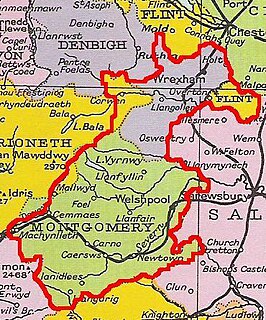Sir Owen Tudor was a Welsh courtier and the second husband of Catherine of Valois (1401–1437), Henry V's widow. He was the grandfather of Henry VII, founder of the Tudor dynasty. Owen was a descendant of a prominent family from Penmynydd on the Isle of Anglesey, which traces its lineage back to Ednyfed Fychan, a Welsh official and seneschal to the Kingdom of Gwynedd. Tudor's grandfather, Tudur ap Goronwy, married Margaret, daughter of Thomas ap Llywelyn ab Owain of Cardiganshire, the last male of the princely house of Deheubarth. Margaret's elder sister married Gruffudd Fychan of Glyndyfrdwy, whose son was Owain Glyndŵr. Owen's father, Maredudd ap Tudur, and his uncles were prominent in Owain Glyndŵr's revolt against English rule, the Glyndŵr Rising.

The Kingdom of Powys was a Welsh successor state, petty kingdom and principality that emerged during the Middle Ages following the end of Roman rule in Britain. It very roughly covered the top two thirds of the modern county of Powys and part of the West Midlands. More precisely, and based on the Romano-British tribal lands of the Ordovices in the west and the Cornovii in the east, its boundaries originally extended from the Cambrian Mountains in the west to include the modern West Midlands region of England in the east. The fertile river valleys of the Severn and Tern are found here, and this region is referred to in later Welsh literature as "the Paradise of Powys".

Madog ap Maredudd was the last Prince of the entire Kingdom of Powys, Wales and for a time held the Fitzalan Lordship of Oswestry.

Powys Fadog was the northern portion of the former princely realm of Powys, which split in two following the death of Madog ap Maredudd in 1160. The realm was divided under Welsh law, with Madog's nephew Owain Cyfeiliog inheriting the south and his son Gruffydd Maelor I, who inherited the north.
Maredudd ap Bleddyn was a prince and later King of Powys in eastern Wales.
Madog ap Gruffudd or Madog ap Gruffudd Maelor, was Prince of Powys Fadog 1191-1236 in north-east Wales.
Gruffudd Fychan II was Lord of Glyndyfrdwy and Lord of Cynllaith Owain c.1330–1369. As such, he had a claim to be hereditary prince of Powys Fadog.
Llywelyn ap Maredudd was a minor Welsh prince of the House of Gwynedd who was the last vassal Lord of Meirionydd. He lived during the mid 13th century. He was the son of Maredudd ap Llywelyn ap Maredudd ap Cynan and was a direct descendant of Owain Gwynedd through his son Prince Cynan, Lord of Meirionydd. He sided with Owain and Dafydd Gwynedd against their brother Llywelyn II in the battle of Bryn Derwin in 1255. After their defeat he went into exile in England until June 1262 when he reconciled with the Prince of Wales. He died the next year on 27 April fighting against the English Marcher Lords. Llywelyn ap Maredudd was a distant cousin and contemporary of Llywelyn ap Gruffudd the last native Prince of Wales and is known to have had the following sons;
Angharad is a feminine given name in the Welsh language, having a long association with Welsh royalty, history and myth. It translates to English as much loved one.
This article is about the particular significance of the century 1201–1300 to Wales and its people.

The history of Gwynedd in the High Middle Ages is a period in the History of Wales spanning the 11th through the 13th centuries. Gwynedd, located in the north of Wales, eventually became the most dominant of Welsh principalities during this period. Distinctive achievements in Gwynedd include further development of Medieval Welsh literature, particularly poets known as the Beirdd y Tywysogion associated with the court of Gwynedd; the reformation of bardic schools; and the continued development of Cyfraith Hywel. All three of these further contributed to the development of a Welsh national identity in the face of Anglo-Norman encroachment of Wales.

Dafydd ap Gruffydd was Prince of Wales from 11 December 1282 until his execution on 3 October 1283 by King Edward I of England. He was the last independent ruler of Wales.
Fychan is a surname. Notable people with the surname include:
Goronwy ap Tudur Hen, also known as Goronwy ap Tudur or Goronwy Fychan, was a Welsh aristocrat and Lord of Penmynydd. He was a member of the Tudor family of Penmynydd, Anglesey, North Wales, and a direct ancestor of Owen Tudor and thereby the Royal House of Tudor. He was a soldier for the English crown, who fought in the First War of Scottish Independence, including in the English invasion which led to the Battle of Bannockburn. He remained loyal to King Edward II of England until the king's death, and was both a yeoman and forester of Snowdon. After his death in 1331, his body was interned in Llanfaes Friary, near Bangor, Gwynedd.
Goronwy ab Ednyfed was seneschal to Llywelyn ap Gruffudd, king of Gwynedd. Goronwy was the founder of the Tudor family of Penmynydd.

Bro Machno is a community in Conwy County Borough, in Wales, formed from the former civil parish of Penmachno. It covers the Penmachno Valley, through which runs the Afon Machno, and includes the villages of Penmachno and Cwm Penmachno. To the south west borders Gwynedd, and is located 4.8 miles (7.7 km) south of Betws-y-Coed, 21.8 miles (35.1 km) north west of Corwen, and 19.4 miles (31.2 km) south of Conwy. The whole of the community is within the Snowdonia national park, while much of it forms part of Gwydir Forest. According to the 2011 census, the population of the Bro Machno Parish was 617, of whom 342 (55%) were able to speak Welsh and 214 (34%) had no skills in Welsh.







